August 11, 2009…72 Year Run Of “The Guiding Light” Ends
August 11, 2009…72 Year Run Of “The Guiding Light” Ends
The Guiding Light is credited by the Guinness Book of World Records as the longest running drama in television history, running from 1952 until 2009, preceded by a 15-year broadcast on the radio.
First broadcast five days after President Franklin D. Roosevelt’s second inauguration, the title “The Guiding Light”, refers to a lamp in the study of Reverend Dr. John Ruthledge (a major character when the show debuted) that family and residents could see as a sign for them to find help when needed.
June 30, 1952 is the day “The Guiding Light” came to television. It’s first TV home was in CBS Studio 56 at Liederkranz Hall on East 58th street, where two of the four studios there had Dumont cameras. After the consolidation of production into the CBS Broadcast Center and colorizing in the mid 60s, Liederkrantz was closed, but ‘TGL’ was a big show so CBS moved it to a facility of it’s own…Studio 65, The High Brown Theater on 26th Street, which had upstairs and downstairs studio floors.
The black and white photo is from September of ’52 in Studio 56. The two color photos are from Studio 65. The studio shot was taken in the basement, while the control room and bigger studio were on the first floor. Occasionally, actors would have to race from one floor to the other to make appearances in the same scene.
‘The Guiding Light’ was created by Irma Phillips, and began as an NBC Radio serial on January 25, 1937. On June 2, 1947, the series was moved to CBS Radio. Even after it’s television debut, the show would continue to be broadcast concomitantly on radio until June 29, 1956.
The series was expanded from 15 minutes to a half-hour in early 1968, which is probably when the move from 56 to 65 occurred. The show expanded to a full hour on November 7, 1977.
The series broadcast its 15,000th televised episode on September 6, 2006.On April 1, 2009, it was announced that CBS had cancelled the show due to low ratings.
The show taped its final scenes for CBS on August 11, 2009, and its final episode on the network aired on September 18, 2009. On October 5, 2009, CBS replaced “TGL” with an hour-long revival of “Let’s Make a Deal”, hosted by Wayne Brady.
With a 72 year run, TGL stands as the fourth longest-running program in all of broadcast history.
At the link is a full 15 minute episode from March 4, 1953 when the show as just 9 months old. The Duz commercial is live, and the pitch man is the show’s announcer Hal Simms. The Ivory commercial appears to be on film. Thanks to Gady Reinhold for the color photos. Enjoy and share! -Bobby Ellerbee
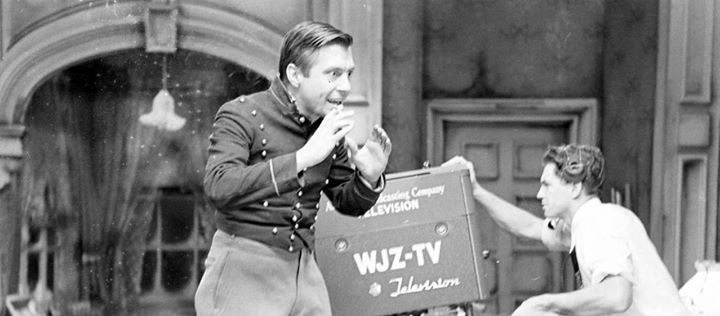

August 10, 1948…WJZ-TV (WABC) Signs On In New York
August 10, 1948…WJZ-TV (WABC) Signs On In New York
New York’s Channel 7 came to life 68 years ago today, so Happy Birthday! Below are articles from “Billboard” and “Broadcasting” that describe the gala night.
Since a lot of us are a bit rusty on ABC television’s owned & operated roots, here’s a short primer.
On April 19, 1948, the ABC Television Network began its broadcasts on its first primary affiliate, WFIL-TV in Philadelphia. Only the month before, ABC bought the Duland Riding Academy at 7 West 66 Street at their network’s new home, which would allow them to leave the space at 30 Rock, that they inherited in the NBC Blue Network deal.
In that it would be four months until WJZ came to the air in NYC,
some of those first ABC shows were shown on Dumont’s WABD. Finally, August 10, 1948, the network’s flagship owned-and-operated station, WJZ-TV in New York City, began its broadcasts. ABC’s other owned-and-operated stations launched over the course of the next 13 months.
WENR-TV in Chicago launched on September 17, 1948, while WXYZ-TV in Detroit went on the air October 9, 1948. KGO-TV in San Francisco went on the air May 5, 1949.
On May 7, 1949, Billboard revealed that ABC would spend $2.5 million to convert the old Vitagraph/Warner East Annex in Hollywood into The Prospect Studios, and construct a transmitter on Mount Wilson in anticipation of the launch of KECA-TV, which went on the air on September 16, 1949. The rest as they say, is history. Enjoy and share! -Bobby Ellerbee
August 9, 1936…Jesse Owens Won His 4th Gold Medal In Berlin
August 9, 1936…Jesse Owens Won His 4th Gold Medal In Berlin
The first live television coverage of a sports event in world history occurred during the 1936 Summer Olympics in Berlin, Germany. These games were televised by two German firms, Telefunken and Fernseh.
Telefunken’s two large stationary cameras were based on RCA technology and the single, smaller Fernseh “roving” camera was based on Philo Farnsworth’s system.
Above, the dark camera is the Fernseh camera and was a bit smaller than the big white Telefunken cameras. Both systems broadcast at 180 lines and 25 frames per second. Four different areas were telecast using three cameras. In total, 72 hours of live transmission went over the airwaves to special viewing booths, called “Public Television Offices” in Berlin and Potsdam.
The cameraman looking into the viewfinder on the Telefunken is Walter Bruch who later went on to develop the Phase Alternation Line System, or PAL that, was initially adopted by more than thirty countries and eventually, more than one hundred. When interviewed by German talk show host Hans Rosenthal on why he had named it the “PAL system”, Bruch replied that certainly no German would want to have a “Bruch-System” because Bruch in German is synonymous with “broken”.
By the way, the Telefunkens appear to have zoom lenses, but they’re not. There were several fixed focal length lens options that could be changed out (a 2 man job), and we can see an example of that in the telephoto lens shot. They have placed the focus mechanism on the outside of the camera instead of inside, and are already using cradle heads instead of friction heads. Enjoy and share! -Bobby Ellerbee
August 9, 1957…”Home” With Arlene Francis Ends Three Year Run
August 9, 1957…”Home” With Arlene Francis Ends Three Year Run
NBC’s “Home” show debuted March 1, 1954 at 11 AM from their 67th Street Studios which were built just a few years earlier by WOR.
The concept came from a show NBC President Pat Weaver had originally titled “Shopping”, and was designed for the upscale female demo. Weaver’s other creations “Today” and “Tonight” are alive and well, but “Home”, the third of the triad, ended with the 893rd and final episode on August 9, 1957.
When Arlene Francis was chosen as the host, Weaver changed the name to “Home” and broadened the scope of the show to add more entertainment and interviews, but each show did have a twelve minute segment on shopping and new products that ranged from food and furniture to clothes and cosmetics.
Instead of trying to present the show on a household type set, NBC spent $200,000 on a circular set that made it clear to viewers that it was done on in a modern television studio. As you can see it was shot “in the round”, but the set also rotated on a huge turntable and was one of the most versatile sets ever. There is also something special about the cameras, that I will point out on the individual photos, so click on those.
As you can see,NBC even built a huge ceiling mounted, remote control camera boom for overhead shots. What you can’t see it the elaborate plumbing the set had. As in the image with the girls with umbrellas, there were often special effects on the set, including a way to make and drain “rain”, as well as operate the kitchen sinks.
In the third year of the show, it was moved to the 10 o’clock hour as CBS was doing their best to counter program with Lucy reruns at 11. Although critics loved the show, it’s aim at the upper class female demo was too narrow and the ratings continued to drop forcing NBC to cancel it. Still under contract for another year, NBC replaced “Home” with “The Arlene Francis Show”, which was much livelier and had more entertainment. – Bobby Ellerbee


August 8, 1974…Nixon Jokes With Crew Minutes Before Resigning
August 8, 1974…Nixon Jokes With Crew Minutes Before Resigning
Forty two years ago, President Nixon announced his resignation to the nation from the Oval Office of The White House. The first seven minutes of this video capture his pre broadcast remarks which, under the circumstances, are truly remarkable, and a bit disturbing.
The CBS crews handled the pool coverage that night with two Norelco PC70s. Sensing a historic moment, a smart network tape operator started recording even before Nixon entered the office. As you will see, a lot of his very odd personality is revealed here.
Although it is not shown, after the speech, he turned to the crew and wished them a Merry Christmas…in August. Well, it was Nixon, after-all.
At the 7 minute mark, his resignation speech starts and the whole thing is here. To bad he didn’t do this a year earlier. Enjoy and share. -Bobby Ellerbee
Moments before he goes on-air to resign as President of the United States, Richard Nixon is calm and collected, joking with staff as they set up the pool fee…
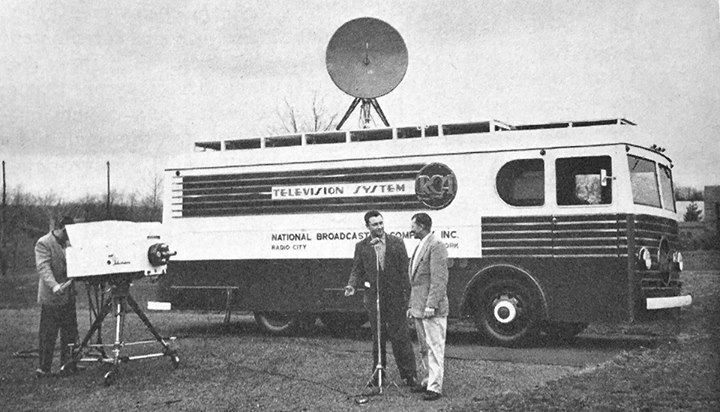

EXCLUSIVE…Inside The First Color Television Remote Unit
Thanks to Chuck Pharis, and his very rare RCA “Red Book”, I have new information and images to share with you, that include not only the first color remote unit, but also, new details on the Washington, Studio 3H and Colonial Theater color trials. I will set the stage with some background on color history, and with some new dates which have been confirmed by RCA information.
Remember, Washington was where the first phase of color experiments were done, with two first generation cameras at Wardman Park studios. Both of those cameras were retired and sent back to RCA in Camden in December of 1950.
The second phase of color testing was done in New York in NBC’s Studio 3H. In January of 1951, work began on the color installation there, and was completed by March. Three experimental cameras were installed in 3H and are called the “coffin cameras” due to their size and black color.
The third phase of color testing began at The Colonial Theater in New York. RCA/NBC leased the theater and began installation in late September of 1952 and the first transmission from here was March 19, 1953. There were four prototype models of the RCA TK40 in operation there, that underwent a full year of tests before RCA began production on the TK40 in Camden.
I felt it would help to refresh your memory, as we now know that this mobile unit was used in both the 3H and Colonial field test. As I mentioned in Thursday’s (8/4) post on this unit, this is one of the original NBC Telemobile units built in 1937.
The first use of the color mobile unit was in September of 1951 with a five day remote test from The Merchant Marine Academy at Kings Point, NY. Support equipment was permanently installed in the unit, but a “coffin camera” was borrowed from Studio 3H, which for a week, sent pictures three times a day. The morning test was shown in black and white on WNBT, to see how the images looked on the monochrome sets. The two afternoon tests were closed circuit color test seen on color sets at The Center Theater, The RCA Exhibition Hall across from 30 Rock, Studio 3H and in Princeton at the RCA Labs.
In 1952, there were over 30 remote tests, including two from Palisades Park NJ, but the big one was on October 18, when two of the coffin cameras were used to telecast, in color, the Columbia-Pennsylvania football game from Baker Field. One of the cameras was equipped with the new RCA Electa Zoom lens, while the other used the a normal field array of lenses on the turret.
Although there were very few color sets, RCA’s main objective with the experimental color broadcasts was to satisfy the FCC, with the fact that their Dot Sequential system was truly “Compatible”- in that it could deliver the same quality image to black and white TV sets, that monochrome broadcasts offered. Via newspaper ads, local viewers was asked to write to NBC with their comments on reception and picture quality of the color segments.
When color operations moved to the Colonial Theater, the new TK40 prototype cameras were delivered, which had very different control equipment. So, the mobile unit had to have a complete refitting, but when remotes were done, cameras were borrowed from The Colonial for a few days at a time. For more, click on the pix. Enjoy and share! -Bobby Ellerbee
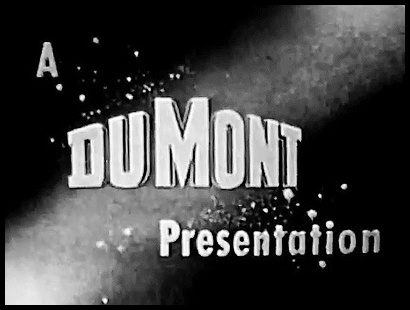

August 6, 1956…The DuMont Network Goes Dark
August 6, 1956…The DuMont Network Goes Dark
In furthering television on a technical basis, DuMont brought a lot to the game, but financially, it had always been an uphill battle. Their deal with Paramount was always a problem, and without radio properties, they had no leverage with AT&T. At the link is the story of the final years. http://www.dumontnetwork.com/7.html
In a nutshell, here is how DuMont began to dismantle its network operations. On April 1, 1955, many of the entertainment programs on the network (including “Captain Video”, DuMont’s longest-running show) were dropped. Bishop Fulton J. Sheen’s last program aired a few weeks later, on April 26 (he would soon move to ABC).
By May, only eight shows remained on the DuMont network, and the AT&T coaxial-cable interconnection to DuMont affiliates in other cities was cancelled. Inexpensive programs like “It’s Alec Templeton Time” sustained what was left of the network during the summer months. A panel show called “What’s the Story” was the last regularly scheduled non-sports program on DuMont, with its final airing on September 23, 1955.
After that date, DuMont reserved its “live” network feed for occasional sporting events. The last program of any kind on the DuMont Television Network was “Boxing from St. Nicholas Arena”, with Chris Schenkel on August 6, 1956, although this show continued locally on WABD in New York City. -Bobby Ellerbee


August 5, 1957…”American Bandstand” Debuts On ABC
On this date in 1957, American Bandstand debuted on the ABC Television Network. Many tell of Dick Clark going to ABC with the show, but…according to Leonard Goldenson, it didn’t happen that way. Mr. Goldenson is the titan that built the network into the one we know today, and this narrative is based on his book, “Beating The Odds”.
In a nutshell, Goldenson’s friend and ABC’s top researcher, Ollie Treyz was responsible for bringing the show to the network. With an insatiable appetite for information, Ollie was reading the Philadelphia rating books and noticed a WFIL show called “Bandstand” had a consistent 15 or 16 rating, which was huge. Treyz was curious and called the man who had brought him to ABC in 1948…that was Roger Clipp who now managed ABC affiliate WFIL for Walter Annenberg.
Clipp sent a kinescope to Treyz, who showed it to his teenage daughter and her friends, who loved it. Treyz played it cool and told Clipp that although they didn’t think it would work, they would like to try it out on the network. They made a deal for $1500 per week for WFIL to produce the show, and Clark got a few spots a week for himself to sell. ABC sold the national spots for $1500 per minute.
At the time, ABC had a fairly competitive prime time, but not much more, which made it hard for them to gain new affiliates. Their afternoons were mostly soap operas and some game shows, but nothing special, with “Afternoon Film Festival” airing daily from 3-5. In the fall of 1955, ratings got a boost with the addition of the “Mickey Mouse Club”. It debuted as a one hour daily show that aired from 5-6. After the first 13 weeks, the MMC went to the half hour format and ran from 5-5:30 from then on.
ABC needed a game changer, and that’s what they got! It only took a few weeks for word to spread, and by Thanksgiving, “American Bandstand” was a hit! In the beginning, the local show, was 2 hours, but when it went to ABC it went to 90 minutes and then 60. In the summer of ’57, when it debuted, ABC ran the show from 3:30-5, and it was followed by “The Mickey Mouse Club” from 5-5:30.
13 weeks later, ABC decided to take advantage of thier new audience, and sandwiched the Johnny Carson hosted “Do You Trust Your Wife” into AB, with AB starting at 3 and DYTYW inserted from 3:30-4, followed by another hour of AB from 4-5. From 5-5:30, ABC rotated daily, “The Buccaneers”, “Adventures of Sir Lancelot”, “Superman”, “Woody Woodpecker” and “The Adventures of Wild Bill Hickok”, followed by “The Mickey Mouse Club” from 5:30 -6.
Of course, all these times are Eastern, which begs the question, how did they handle the west coast feed? Well, fortunately, by this time, ABC had a few of the new Ampex VR 1000 video tape machines in operation. The machines debuted in April of ’56, but it took a while to put them into production and get them delivered, and the networks got the first ones. I think CBS and NBC got 6, and ABC got 4 in the spring/summer of ’57.
Just two years earlier, the Dumont Network had gone dark making ABC the new third network, but NBC and CBS were light years ahead in programs and schedules. Bandstand and Mickey Mouse helped bridge some of that gap. The show ran for 30 years on ABC, first on weekday afternoons and later, on weekends. I would rate it a 10, how about you? Got a favorite Bandstand moment? Enjoy and share! -Bobby Ellerbee
Ultra Rare New Photo…The Very First Color Mobile Unit
Ultra Rare New Photo…The Very First Color Mobile Unit
This is the first, and only photo of the first color unit I have ever seen. Not much is known about this first RCA/NBC color mobile unit, but this rare new photo helps a lot in fleshing out the backstory. The top photo shows the unit, with one of the four RCA TK40 prototype cameras from The Colonial Theater, sometime between October 1952 and late 1953.
The photo with the girl in the swimsuit shows one of the three experimental color “coffin cameras”, from NBC Studio 3H on what is believed to be the first color remote test. It was taken at Palisades Park NJ, in 1952. The closed circuit broadcast was sent back to 30 Rock, and to RCA in Camden for appraisal by the engineers.
(FYI, these black “coffin” cameras are the second generation of RCA experimental color cameras, which came into use in 1950 after the RCA color tests moved to NY from Washington. The first generation was used at The Wardman Park Studios in Washington from 1947-1950 and those cameras were sent back to Camden. The third generation of experimental color cameras were the four TK40 prototypes installed at The Colonial Theater in late ’52. Mass production of the TK40 did not start until April ’54).
My historian friends and I have always wondered just how they did that Palisades Park remote. Did they take the equipment there and set it up, or was there a mobile unit? We had heard there was a mobile unit, but no one had seen it. Now we know, and it appears that this is one of the original 1937 NBC Telemobile units, that has been taken out of mothballs and converted for color remote tests.
If you remember, the original NBC Telemobile unit was a two bus affair, one was the camera control unit, the other, the transmitter unit that could transmit a TV signal from its 50 foot tower, about 60 miles, back to 30 Rock. Given the microwave dish up-top, it appears that this unit is now able to throw a color microwave signal, and handle at least one camera, and maybe two.
Thanks to my friend and mentor Chuck Pharis for the rare photo, which comes from something just as rare…The RCA Red Book, which as I understand it, was an RCA book prepared and published for presentation to the FCC, on their dot sequential color system. Enjoy and share! -Bobby Ellerbee
How Peter Pan Flew…On Broadway And In The TV Classic
How Peter Pan Flew…On Broadway And In The TV Classic
Peter Foy was the man responsible for the “flying” effect that all of us, of a certain age, remember with great fondness. Flying one person gracefully is an art…flying four at a time is magic!
Thanks to Terry Wilkie, the TD at Caesar’s Entertainment in Las Vegas, here is an interview with Foy that discusses the finer points of how it is done. Enjoy! -Bobby Ellerbee
Happy 90th Birthday! Tony Bennett…Born August 3, 1926
Happy 90th Birthday! Tony Bennett…Born August 3, 1926
Anthony Dominick Benedetto was born in Astoria, Queens, New York 90 years ago today.
In a nutshell, here’s how Mr. Bennett’s career began. In 1949, Pearl Bailey, who had seen him in a club, asked him to open for her in Greenwich Village. She had invited Bob Hope to the show. Hope liked him and decided to take Benedetto on the road with him, and simplified his name to Tony Bennett. In 1950, Bennett cut a demo of “Boulevard of Broken Dreams” and was signed to the major Columbia Records label by Mitch Miller.
In 1951, he had his first big hit…”Because of You”, a ballad produced by Mitch Miller with a lush orchestral arrangement from Percy Faith. https://www.youtube.com/watch?v=i-4zvArJDGg
His first release started out gaining popularity on jukeboxes, then reached number one on the radio play charts in 1951, and stayed there for ten weeks, selling over a million copies. The rest, as they say, is history.
Above is a rare photo of Mr. Bennett on the “Tonight” show, October 1, 1962. That was the night Johnny Carson made his debut as host of the show, and Tony Bennett was the musical guest Johnny Carson invited to share that special the night with. Happy Birthday Tony! Enjoy and share! -Bobby Ellerbee
August 3, 1944…One Of CBS Television’s First Game Show Debuts
August 3, 1944…One Of CBS Television’s First Game Show Debuts
Pictured here is John Reed King hosting “Missus Goes A Shopping”, which debuted on August 3, 1944, This is inside CBS Studio 42 at Grand Central Terminal. I will reveal the surprise of who the woman in the hat is a few paragraphs down.
The first CBS game show on television was actually the “CBS Television Quiz”, which aired on Wednesday nights on WCBW from July 2, 1941 to May 25, 1942. The host was Gil Fates, who went on to be executive producer of “What’s My Line”. Due to the war, the show left the air, as the broadcast schedules for both NBC and CBS flatlined.
With optimism on the war in Europe spreading, TV began to percolate and more time was added to broadcast schedules. “Missus Goes A Shopping”, began on radio in 1941 and ran there till 1951, which King hosted until the show moved to TV. With it’s radio success, CBS figured it would be a good bet to add to its TV line up, and it was. A daytime television version began on November 19, 1947 and ended on November 10, 1948.
So, who is the woman? Hint…she was the scorekeeper on “CBS Television Quiz”. Didn’t help? OK…she is none other than Francis Buss…television’s first ever female director!
In addition to his radio and television quiz shows, Mr. King was also notable as the voice of many Paramount newsreels, and for a time he was coordinating producer of the series. His voice can often be heard on the Turner Movie Classics cable network when the movie newsreels are replayed from time to time.
One of John’s best known roles in radio was as the star of “Sky King”. In television, he is celebrated as the producer of one of the most popular series of the late 1950’s, “Death Valley Days”, which featured, among other hosts, Ronald Reagan. Enjoy and share! -Bobby Ellerbee
Above, Francis Buss…television’s first ever female director
THE NBC BUILT, ND-8G CAMERAS
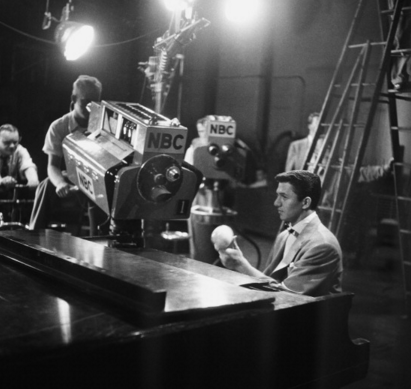
UPDATED March 3, 2023: Around 2010, I found a photo of an odd looking NBC camera in use in 1947. Not knowing what else to do, I passed around a picture to a group of what I consider REAL experts. There was a lot of discussion but finally Ed Reitan, who has the great Early Color Television site http://www.earlytelevision.org/Reitan/index.html came up with part of the answer and I have worked on developing the rest of a great back story and timeline and have found never before seen pictures, so here it is.
The reason they do not look very RCA, is because they were not built by RCA…they were being built by NBC engineers at 30 Rockefeller Plaza in New York beginning in late 1945! So now that we know WHAT they are, the next question that begs to be answered is WHY they are!
Well, if you think of RCA as the baker and NBC as the sandwich maker, the sandwich makers knew how hungry people were going to be for entertainment when the war was over, and that they would be coming for sandwiches is a big way. The problem was, most did not think the baker would be able to make bread fast enough. This is why the NBC New York engineers went ahead of RCA to get some hardware ready for what would happen, once World War II ended in 1945. RCA was projecting early ’47 as delivery dates on their new RCA TK10 and TK30 Image Orthicon cameras, but everybody else in TV thought that was a very optimistic date, given all the war shortages including white phosphorus needed for viewfinder and home receiver screens.
Remember…RCA was busy making radar and radio communications equipment for the U S armed forces and even when the war would come to an end, it would take many months or even a year or more to swing production back to the civilian needs. RCA did understand NBC’s point of view, which is why they gave them 4 of the new Image Orthicon tubes and the associated yokes and other equipment for their ND-8G cameras. Not only would it put them ahead with hardware, but getting the new parts into use would allow a longer runway for testing and trouble shooting before RCA went into mass production on their new TK series cameras.
In reality, NBC got 4 TK30s from RCA for the June 1946 Joe Lewis-Billy Conn fight and in October of ’46, the TK30 cameras were made available to broadcasters on a limited basis. At first, NBC had priority and got theirs first. Many of the new TK30s sold to non NBC affiliates came without viewfinders on delivery, until the white phosphorous shortage was overcome and back ordered viewfinders were delivered.
NBC built a lot of custom things for special uses inside the company and they cataloged their creations by giving them a New Development, or ND number. No one I’ve spoken to knows what this camera was actually called, or what its ND number was, but the reason I call it the NBC ND-8G is because the 4 cameras built were only used in NBC studio 8G in Radio City. That was the first large radio studio converted to use for TV because it was a 2 story studio and allowed room to add the light grids. Studio 3H was the first converted from radio to television in 1935 by RCA as the birthplace of experimental electronic television. Compared to 8G, it was only a third the size.
PART OF THIS REVISION IS TO SET THE RECORD STRAIGHT AND UPDATE THE TIME LINE OF THE CAMERA’S AND STUDIO’S USE. The article below from the July 1948 issue of RADIO AGE is the chief culprit in misreporting the timeline of the camera and the 8G studio history in places other than Eyes Of A Generation. It leaves people wondering why NBC would build these cameras in 1948, when RCA was supplying them with new TK10 and TK30 models as early as June of 1946!
THE PROBLEM…the author uses the official NBC studio dedication date of April 22, 1948 to base his assumptions on, BUT…radio studio 8G had been being used for television since at least May 9, 1946 when “Hour Glass” – television’s first variety show debuted, and NBC was building these cameras in late 1945.
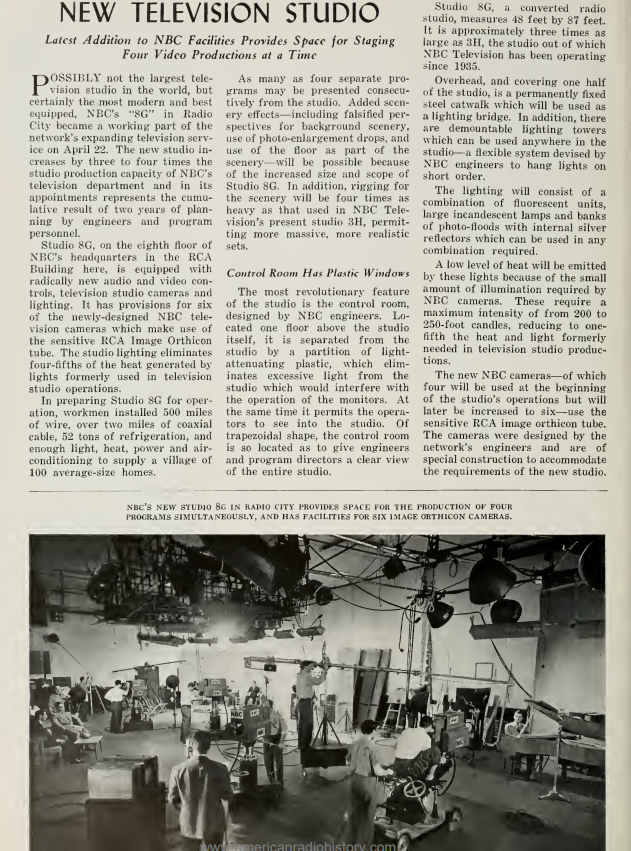
Now, all of the information in the article is true in 1948, but it was not true in 1946 when radio studio 8G had been drafted into use as a television production “stage” too. Daily radio shows were done here, usually with audiences (folding seats) in the early part of the day, but later the lights and ND-8G cameras rolled on to the studio floor and it was TV time.
One of the best ways to show you what was going on is to present this video…HERE, WE SEE FILM SHOT IN NBC STUDIO 8G, OF TV’S FIRST VARIETY SHOW “HOUR GLASS”. This was television’s first non-scripted entertainment show, and the performers here are the acrobatic, dancing Costello Sisters in their mini costumes. So, now, you’ll be one of the few people to not only have seen this show, but also to know what the show is and who the dancers are.
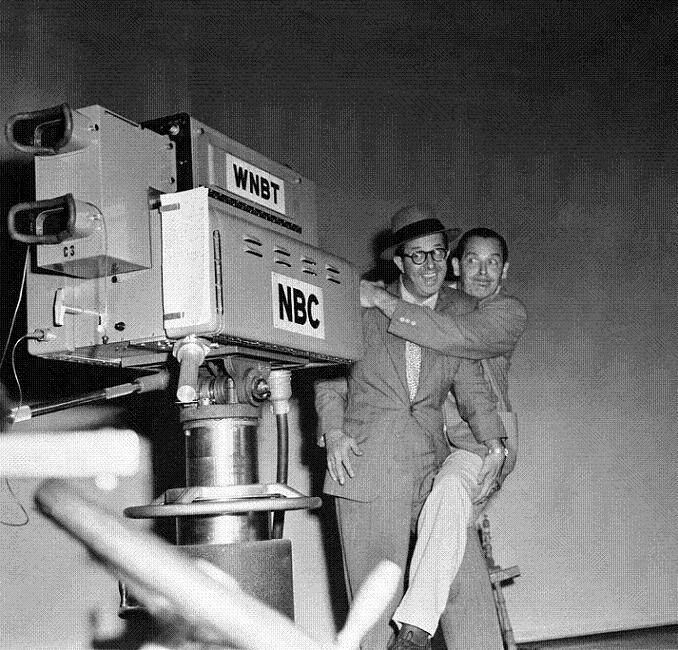
Milton Berle and Phil Silvers mug for this very unusual looking camera. Notice the 2 viewfinders and the right handle that closely resembles the RCA TK40 and 41 handles that allows focus control. The reason for the dual viewfinders was to give the cameraman the ability to see the scene in the viewfinder, even if the camera was up high.
Below, “Uncle Miltie” goofs around in front of one of these cameras and IS looking into the taking lens.
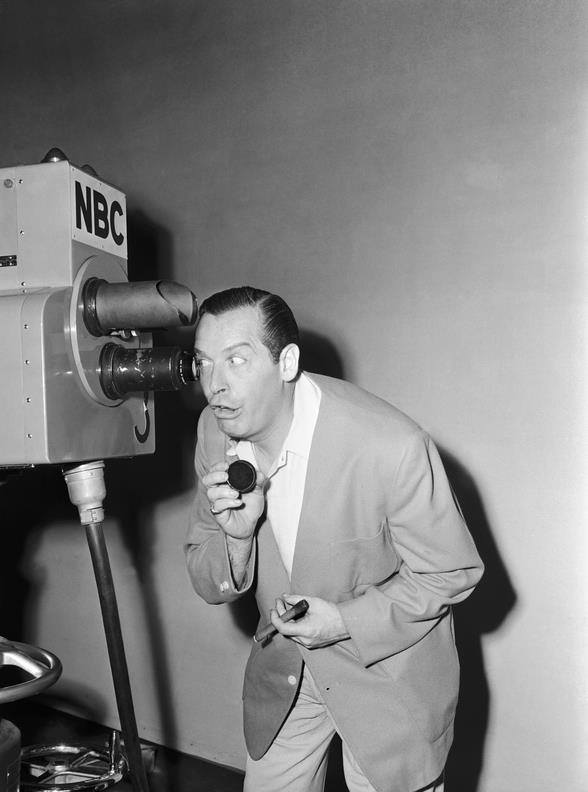

From the front, notice that it does have a turret but only three lens positions. The man at the piano I think is Buddy Greco.
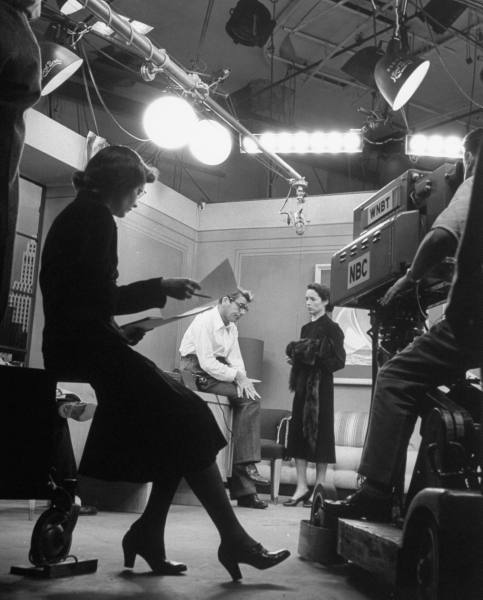
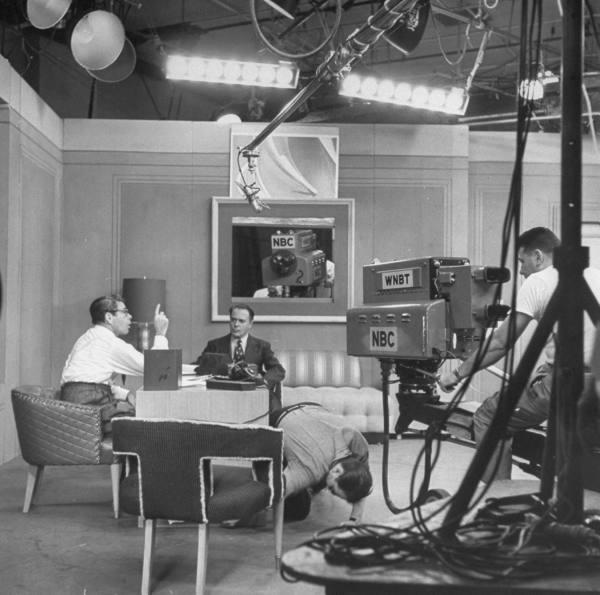
Here they are in use in the October 1948 presentation of the Philco Playhouse in Studio 8G. Notice the wall hanging in the picture above. A pretty clever way to get an otherwise impossible shot.
Studio 8G shots from the spring of 1948.
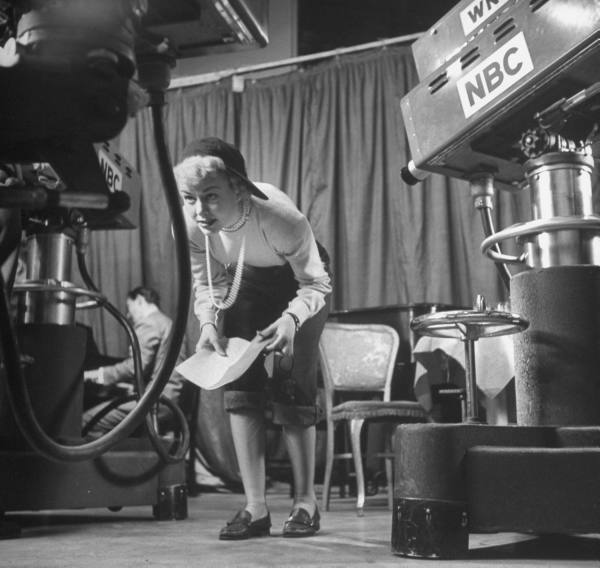

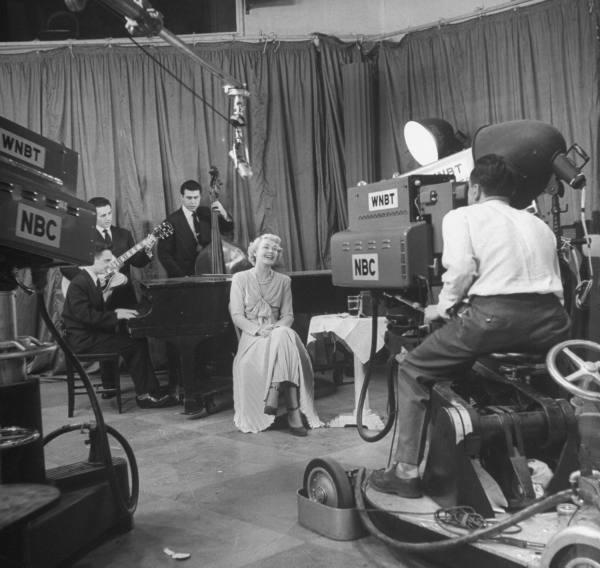
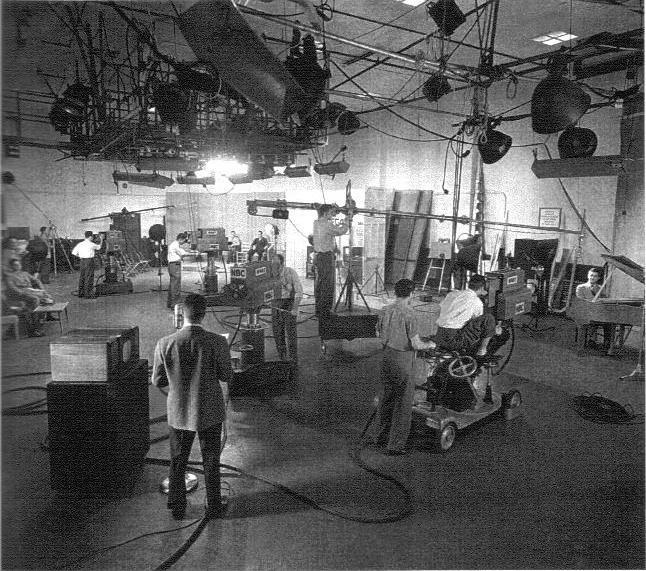
In the only known photo of its kind, here are all 4 of the NBC build cameras at work in Radio City’s Studio 8G…their permanent home. Two more were scheduled to be built and added here, but they never got here. There is a rumor that the four more of these were built and sent to NBC’s new Washington DC station, WNBW in mid 1947, but it is just that…a rumor.
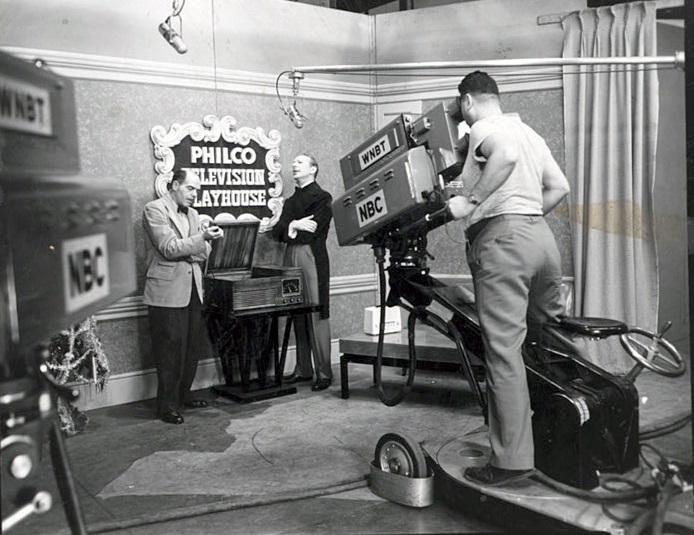
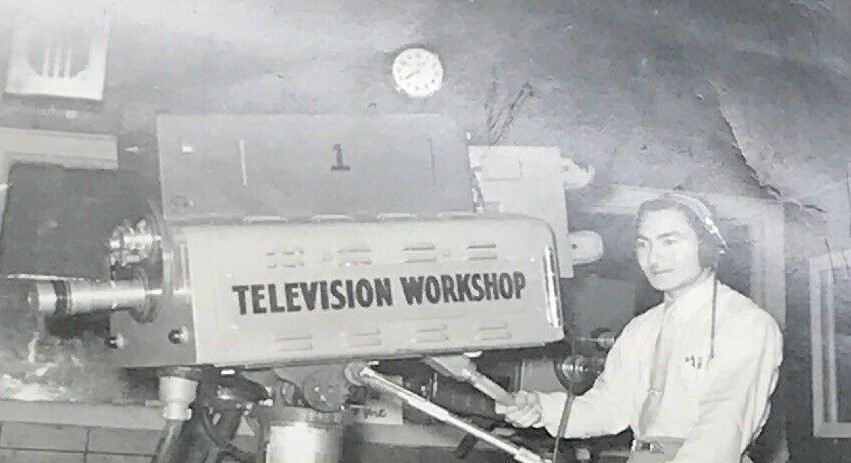
August 2, 1942…”Here’s Looking At You Kid” Is Immortalized On Film
August 2, 1942…”Here’s Looking At You Kid” Is Immortalized On Film
74 years ago today, the final scene of “Casablanca” was filmed on Stage 21 at Warner Brothers. They also shot on Stage 04, Stage 05, Stage 06, Stage 07, Stage 08, Stage 09, Stage 11, Stage 12, Stage 14, Stage 17, Stage 18, Stage 25 and French Street on the backlot. Some of the sets used in “Casablanca”, were leftovers from “The Desert Song”, and “Now Voyager” with Bette Davis.
The whole picture was shot at Warner’s except for the sequence showing Major Strasser’s arrival, which was filmed at Van Nuys Airport, and a few short clips of stock footage views of Paris were added for effect.
This scene on the “runway” was purposefully over fogged to hide the deficiencies in the cardboard mock up of a Lockheed Electra which had very short extras around it to help cheat the proportionality.
Speaking of cheating, Bogart was two inches shorter than Bergman, so…like in this scene, he wore wooden block lifts on his shoes, and sat on pillows to hide the difference.
This scene also gave us, “We’ll always have Paris” too. It is thought that the “Play it again Sam” line was delivered on Stage 11. -Bobby Ellerbee

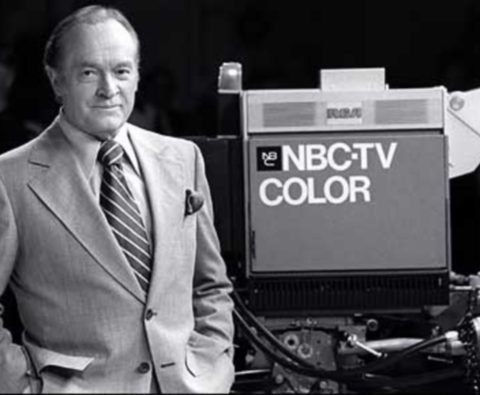
THE SECRET BACKSTORY OF THE RCA TK 44
Chapter One: by Bobby Ellerbee
Over a period of months in 2009, I spoke to former RCA engineers Lou Bazin and Larry Thorpe, and to Fred Himelfarb of NBC, about a troubled period for both companies…the 1960s. Those conversations focused on topics from how the RCA TK41 cameras continued to evolve, to what happened when the TK42-43 did not evolve. There is more on this on the RCA TK60 page, so please visit that too.
That topic led to my first hearing of the secret back-story of the TK44A development. I have written my account of these conversations below. What is now the first chapter was sent to the principals for comment and later, for ‘color commentary,’ I sent it to two eminent television historians, Lytle Hoover* (RCA) and Jay Ballard** (NBC/ABC). As you will see below, Jay and Lytle have added a whole new second chapter, and so we begin.
When RCA came out with the ‘new look’ TK12 in 1960 (which became the TK60 in ’63), they began to feel it was time to replace the TK41s with a new model; the TK42, and had an experimental model at the NAB show as early at 1962 as seen below.

In essence they wanted to put a TK41 and a TK60 in the same camera head. They wanted the TK60s 4 1/2 image orthicon, so the image broadcast to the millions of still mostly black and white receivers was sharp, but also wanted the kind of great color images that came from the TK41. With the plan to put the lens inside the TK42, that did not leave enough room for the three image orthicons and optics from the 41, so they opted for color vidicon tubes.
As a young engineer at RCA, one of Lou Bazin’s assignments was to work directly with Fred Himelfarb *** , “Pharaoh of all cameras at NBC”. Originally an RCA engineer himself, Fred had moved to NBC with the TK40s to be the master link between theory and reality. At NBC, Fred could see the cameras in their real working environments and adapt solutions to improve the 41s’ pictures and operations. He was in constant touch with Lou, and thanks to Fred, RCA made lots of hugely productive modifications to the TK41s and built in as they were made. One of the many improvements was Fred’s design of a new single camera cable to replace the 3 cable design on the early TK40s and 41s.
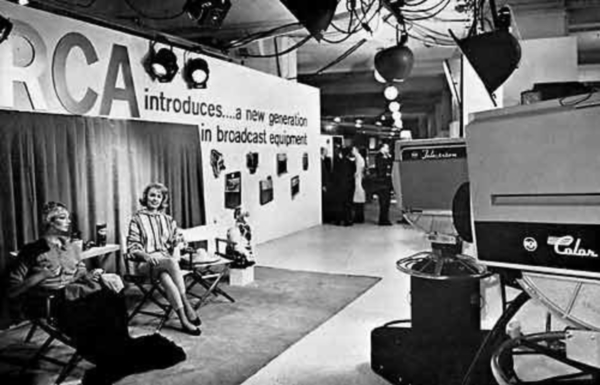
Above is the experimental TK42 at the 1964 NAB convention…one that is now legendary. This was the year the Norelco PC60 debuted, and the year RCA brass pulled the plug on the TK42. Literally…they turned it off and left it off. Seems that after station owners saw the plumbicon tube pictures, they were asking RCA too many hard questions about why the four-tube TK42 pictures were not that good. (On the left, the newly-renamed RCA TK60; on the right, the experimental RCA TK42).
Remember…RCA stopped making the TK41 in 1964, but NBC needed new cameras and they were not happy with the TK42. Below is an extremely rare artifact that I hope you will read. It is a two page RCA memo from May of 1964…Fred Himelfarb’s comments on the preliminary engineering model of the TK42. The intrigue continues after the memo.
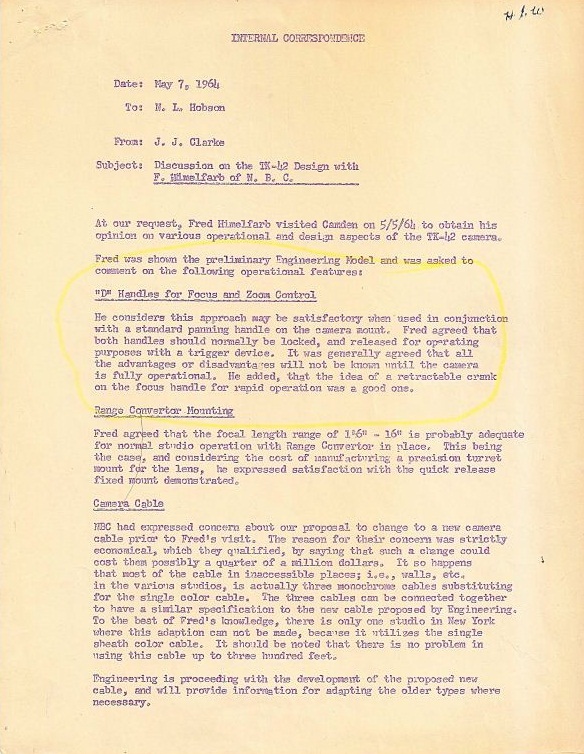
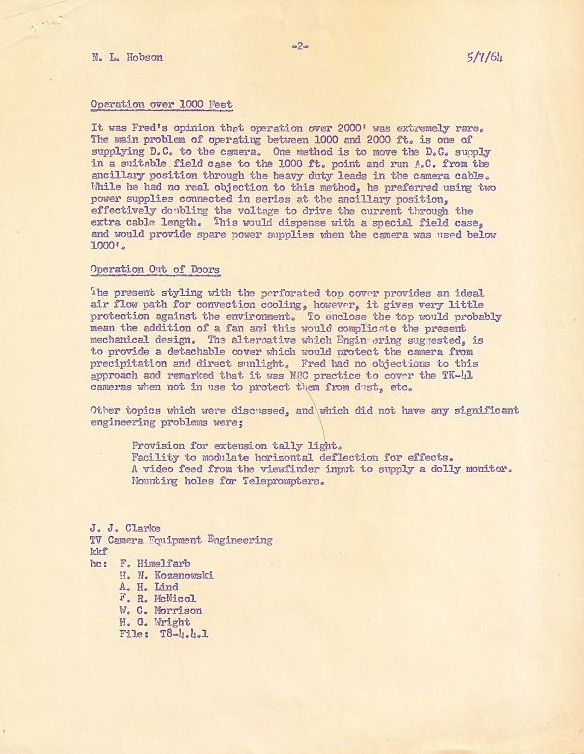
It was 1965 when the TK42 got its final ‘new look’ style and 60 were shipped to local stations as none of the networks ordered any…not even NBC. The four tube design and lens ‘chatter’ were big problems for them, but more on that below. With the Norelcos out now, RCA worked to find a way for the TK42 to match the picture quality of the PC60 but were not having much luck.
With nothing on the drawing board at RCA that could equal the new PC60, the ‘sin of all sins,’ the unthinkable, was being thought by NBC management…maybe they would buy cameras not made by RCA. Finally the word came. In late ’65, Fred was instructed by management to buy 35 Norelcos for NBC’s remote trucks, but not before he worked with Norelco on custom improvements.
The RCA corporate strategy to go ‘all out’ on the TK42 was a problem at many levels, including the ego level, but this is where a great back story begins…the stealth, ‘off the books’ development of the TK44A! Yes, RCA was already thinking of the TK44, BUT, they were still thinking 4 tubes!
Under RCA Broadcast Manager Andy Ingles, Norm Hobson was the management’s link and Lead Engineer on the TK42-43. Norm suspected that soon, there would be something other than the 4 tube TK44 design needed, so he told Lou Bazin that he “found some money” in another project, and Lou got started on a 3 tube TK44A design long before everyone realized the 4 tube version would not “cut the mustard.”
Upper Management at RCA did not have any idea that plans for a 3-tube A version was in the works, but it turns out that they were glad it was happening because it saved a lot of time when word came down from the top that it was time for something new. Larry Thorpe and Lou Bazin were both fairly new RCA engineers and worked under Hobson. They were both in on the ground floor of the stealth TK44A project. Fred knew too – and remember, Fred was working with Norelco to improve the pictures for the NBC version of the PC60. RCA engineer Harry Wright was in on it too because Harry was the mechanical engineer for the 42, 43 and 44. Please visit a special section on Harry in the Archives section to see the very first sketches of all these cameras and more one of a kind images.
Now the plot thickens AGAIN! While trying to work out a 3-tube design, Lou and another RCA engineer got a very unexpected invitation from Amperex to come visit and look at the possibilities of using their tubes in RCA cameras. Amperex was a Philips subsidiary (as was Norelco) and the US source for the new Plumbicon tubes and yokes…the main component of Norelco’s ‘magic pictures’. This was a ‘no no’ as Amperex was not authorized to share this technology with RCA…but Philips was way over there in Holland and Amperex was just a short ride from Camden. There was money to be made is selling tubes to RCA. Interestingly the plumbicon tubes were made in Rhode Island at another Philips subsidiary. I have a feeling Fred Himelfarb had a hand in this unexpected invitation. After all, he was already working with Philips and Amperex for their cameras with the shorter custom plumbicons.

Above is the 1967 artist rendering of the experimental TK44, but this is not to be confused with the great TK44A that used three Plumbicon tubes. This is a 4-tube camera, using an image Isocon tube in the luminance channel, and was a camera that came out just after the 42 – just before the 44A in ’68. More on this below from Jay and Lytle.
With all this brain power studying the Norelco, it wasn’t long until the RCA TK44A 3-tube Plumbicon camera was introduced, and the first ones were sold to WBAP in Dallas and delivered in early 1968. The TK44As made better pictures than the Norelco and were much more stable.
Lou told me that to prove the stability point, Fred once sprayed Freon on one of the Norelco preamps and the picture just fell apart…registration went nuts. Then he sprayed the TK44. Although the preamp circuit board had frost all over it, the picture never even wavered.
My original draft of this story was sent for comment to all the principals and the reply from Jay and Lytle has basically added another chapter to the TK44 story.
Chapter Two: by Jay Ballard and Lytle Hoover
There is one chapter missing in the evolution of the TK-44A from the TK-42. RCA developed an interim camera between the TK-44A (plumbicon) and the 42/43-it was called the TK-44, and was a 4-tube camera, using an image Isocon tube in the luminance channel. The Isocon was used in astronomy applications and had very low noise, but could not handle the dynamic range encountered in television. The TK-44 (not 44A) was thought of as a field version of the 42/43, but still retaining the 4 tube concept.
When the TK-44 was brought outside, the picture bloomed in the intense daylight, and the story goes that Harold Seer, another RCA engineer, knew than that this design was not going to fly. The TK-44 never went into production.
Another component that made the Philips camera successful was the small prism, which RCA initially bought along with the yokes and the tubes. They were the key to the success of the PC-60/70 series. True, RCA later upgraded the TK-41 to prism optics, but the 30mm tubes made the prism much smaller than the one used for the 3″ IO.
I believe that both GE and RCA had designed lead oxide tubes, but only the Philips people were able to produce a stable target in quantities. Hats off to the Eindhoven scientists. The design was later licensed to EEV, Matsushita, and RCA with the Vistacon.
In the mid 60s, the only high-end 3-tube design was the Norelco (although Norelco experimented with a 4-tube design in Breda, per Fred van Roessel). Everyone else was 4-tube, with a luminance channel. You can see why, as there was still a large monochrome viewing audience, plus germanium transistor circuitry was prone to drift, and the 4-tube design always gave a non-derived, wide band luminance signal. It even spilled over into telecine design (TK-27, PE-240,etc).
The 42/43 sold about 500 units because the color conversion was underway and there was a desperate need for cameras and lenses. Station managements trusted RCA for its magnificent support organization, its unequaled sales force, research facility in Princeton, huge variety of products, engineering expertise; all the legends fostered by Gen. Sarnoff. But the 42/43 left RCA with a black eye, and many loyal customers turned to GE, Philips, Marconi, and others.
The Japanese were not yet a force in the world scene-yet. Station managements were also much more tolerant and trusted their chief engineers. They were making so much money in the pre-cable days-who cared if the cameras weighed 280 lbs and were noisy? Some of these stories were documented in Andy Inglis’ book Behind The Tube.
The TK-44A was a great success for RCA, and deservedly so. Almost 800 were sold, according to my customer list. Fred had a lot of input on the design. It was a big improvement over the Norelco cameras-the power supply concept, automatic cable compensation, a video operator’s dream. There were problems with cold solder joints, and grounds, but they were repairable. The TK-44-A/B spanned 20 years at NBC. Successors TK-45/46 were also popular.
Footnotes
* Lytle Hoover was a television director before becoming the manager of market research at RCA from 1968-82 and is a hugely important source of information on all things Television. His site at http://www.oldradio.com/archives/hardware/TV/RCA-TV.htm is the most comprehensive RCA history site on the world wide web.
**Jay Ballard is a world class Television historian who has recently retired from ABC NY as the engineer in charge of pre testing all the equipment the network is considering adding. Before moving there, Jay worked over twenty years at NBC’s 30 Rockefeller Plaza headquarters with NBC legend Fred Himelfarb.
***Fred Himelfarb worked at NBC from 1950 to 1990. His title when he retired was Principal Engineer of NBC Television. Unfortunately for all of us, Fred shed his mortal coil in April of 2010. Although gone, he is not forgotten.

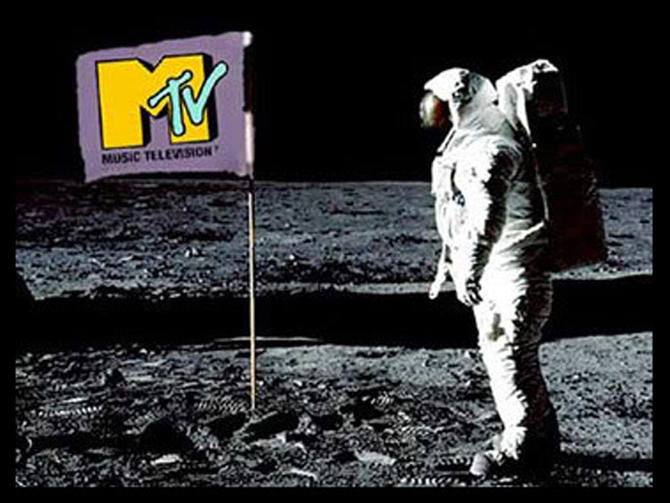

August 1, 1981…MTV Debuts
August 1, 1981…MTV Debuts
The day that video killed the radio star
On August 1, 1981, MTV was born, starting its very first ever broadcast with the appropriate 1979 hit “Video Killed the Radio Star.”
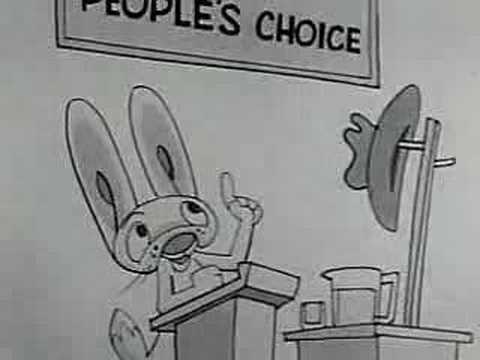

August 1, 1949…The First Made For TV Cartoon Debuts
August 1, 1949…The First Made For TV Cartoon Debuts
“Crusader Rabbit” was the first animated series produced specifically for television. The limited animation concept was test marketed in 1948, while the initial episode (below), aired on KNBH (now KNBC) in Los Angeles on August 1, 1949.
“Crusader Rabbit” was the brainchild of Alex Anderson, the nephew of animator Paul Terry. Terry, a former newspaper cartoonist, founded animation studio Terrytoons, where he created “Mighty Mouse” in 1942. More importantly, Terry pioneered the techniques of limited animation for television, allowing his studio to compete with better-funded rivals like Disney.
When Anderson saw a television for the first time, he realized his uncle’s cheap, fast techniques might make it feasible to move animation into the new medium. Terry was uninterested with Anderson’s pitch of an animated TV show…or, more accurately, worried that Terrytoons’ theatrical distribution partner Fox would drop them if they started doing business in the threatening new medium, so Anderson returned to Berkeley and set out on his own.
While working with his uncle at Terrytoons, Anderson had pitched a character called “Donkey Hote” that was passed on by animators who didn’t want to draw donkeys. Anderson changed the character to an easier-to-draw rabbit, but kept the idea of Quixote, and “Crusader Rabbit” was born.
Since the character was unnaturally bold for a rabbit, he paired him with an unnaturally cowardly tiger named Rags. His uncle let him keep the characters for his new venture.
To get Crusader and Rags on television, he teamed up with Jay Ward, a classmate and friend of his going back to grammar school. Ward had returned West from Harvard Business School with plans to get into real estate but was hit by a truck on his new venture’s first day. Anderson approached him while he was convalescing with the idea that they could form an animation studio together, Ward handling the business and Anderson handling the animation.
The studio they formed was Television Arts Producers. Producer Jerry Fairbanks originally landed the show at NBC, but the network eventually passed, which meant Fairbanks sold it piecemeal to affiliates. The first one to bite was KNBH in Los Angeles (now KNBC), and on Aug. 1, 1949, audiences were introduced to Crusader Rabbit and Rags the Tiger.
Of course, Anderson couldn’t afford the kind of animation that made the Disney shorts work. Each episode is no more than five minutes long, with 10 to 15 episodes making up a single crusade, and, frame to frame, looks more like a comic strip than motion animation.
In some markets, “Crusader Rabbit” was dropped into shows like Romper Room, so, because there was no guarantee that audiences would see the episodes in order, each episode begins with gradually longer and longer recaps, and by the end of a crusade, more than half of the show is recaps. Which, of course, means that half of the show was already animated.
After 195 episodes, the show collapsed in lawsuits: Jerry Fairbanks had borrowed production money from NBC and not repaid it; NBC foreclosed on the show without letting Anderson or Ward know. Another studio bought Television Arts and, with it, the rights to the character, producing more episodes (in color, this time) in 1956.
As Crusader Rabbit collapsed, Anderson and Ward created two new characters that would later meet with lasting success: “Rocky and Bullwinkle”.
Rocky and Bullwinkle’s future, like Crusader Rabbit’s, was litigious: Ward registered them for copyright in his name alone, and Anderson had to sue his heirs to be recognized as the co-creator.
“Rocky and Bullwinkle”, like many shows to follow, was hailed for being ahead of its time in its use of sophisticated jokes, but “Crusader Rabbit” got there first. Without it, animated shows aimed entirely at adults, might never have come about. -Bobby Ellerbee
Jay Ward’s Crusader Rabbit – Crusade 1 / Episode 1. Like to see more?
Camerus Giganticus Maximus!
Camerus Giganticus Maximus!
Except for cameras shooting through a telescope, this is the biggest rig I have ever seen! Attached to the front of this RCA TK41 is a giant Fujinon 200 MM zoom lens.
Although it being photographed on the set of “Concentration”, I would find it hard to believe that it was actually used on the show. More than likely, as was/is fairly common, this was a demonstrator sent to NBC to play with for a few weeks, and this was the studio test for the brass inside 30 Rock. To really put it to the test, it would have to go to the field units for a good workout at a sporting event.
With only the regular 4 lens turret, the TK41 was 5 feet long. With the usual Rank-Taylor-Hobson 10X zoom, it was over 6 feet. This beast must be at least 8 feet. Thanks to my friend and mentor, Chuck Pharis for sending this. Enjoy, marvel and share! -Bobby Ellerbee
July 31, 1995…The Circuit Is Reversed As Disney Buys ABC
July 31, 1995…The Circuit Is Reversed As Disney Buys ABC
Did you know that in the beginning, ABC invested in Disney?
In the early 1950’s, Walt Disney sought corporate sponsorship for his Mickey Mouse themed amusement park. Desperate for quality programing, the new CEO of the American Broadcasting Company, Leonard Goldenson, lead ABC to become Disneyland’s primary backer. Following a $500,000 investment to subsidize Disneyland’s construction, the ABC network received a 35% share of park profits and exclusive programming from Walt Disney Studios.
The sponsorship immediately paid dividends. In 1954 the ABC network began televising “Disneyland”, a series of hour long specials, which featured old Disney Films, studio documentaries and new Disney Studio features. The extremely popular Davy Crockett debuted on the Disneyland series, and soon after, “Davy Crockett, the Indian Fighter”, and “The Mickey Mouse Club” came to ABC. The popularity of Disney programming boosted ABC’s ratings, and when Disneyland park opened in July of 1955, ABC aired the special event live, with the biggest ever remote broadcast at the time.
Walt Disney continued to host the “Disneyland” series, which was renamed “Walt Disney Presents” in 1958. ABC aired the successful programs until 1961. A dispute over Disneyland profits and the ability to broadcast in color, pushed Walt Disney to move to NBC, where Disney hosted “Walt Disney’s Wonderful World of Color”, appearing on NBC until his death in 1966.
One other dividend that is not often mentioned is the fact that, despite all of the efforts from NBC and CBS to have the Hollywood movie makers supply television with programing, it was ABC’s association with Disney that finally broke the logjam. Soon, the screens were full of westerns, and detective stories from the west coast.
On July 31, 1995, Walt Disney Co. agreed to acquire Capital Cities-ABC Inc. in a $19 billion deal. The rest as they say “is history”. -Bobby Ellerbee
July 31, 1970…Huntley-Brinkley Say Goodnight For The Last Time
July 31, 1970…Huntley-Brinkley Say Goodnight For The Last Time
The final minutes of the last broadcast, and more, were captured on this work tape (link below) from my friend Bob Maher. Here, we see rare video of not only Chet’s NBC sign off, but also…Walter Cronkite’s tip of the hat, with A VERY SPECIAL SURPRISE ENDING. The tape should start at 11:44. Cronkite’s tribute is first, followed by the memorable NBC sign off.
In the summer of ’56, Chet Huntley and David Brinkley had been paired by NBC to anchor their political convention coverages. It was producer Ruven Frank’s idea to use them at the conventions, but when it was suggested the two men take over the nightly news reporting from John Cameron Swayze, Ruven “thought it was the dumbest idea ever”.
Bill McAndrew was the NBC News boss, and had seen a two man team reporting from different cities on NBC affiliate WSAZ in West Virginia, and liked it. While Ruven Frank was coming around to McAndrew’s way of thinking, Swayze was losing more of the audience to Douglas Edwards on CBS, so the change was made.
At first, the ratings went even lower, but after a year of seeing Huntley in New York, and Brinkley in Washington, the audience began to build and by 1958, the team had won a Peabody Award.
“The Huntley-Brinkley Report” aired from October 29, 1956, until July 31, 1970. Before it, “The Camel News Caravan” with John Cameron Swayze was NBC’s nightly news show, and after Huntley-Brinkley, it came The “NBC Nightly News” with David Brinkley, Frank McGee and John Chancellor. Only in September of ’63 did the show go to half an hour from fifteen minutes…a week after CBS gave Walter Cronkite a thirty minute show.
I remember watching every night and especially remember their famous sign off…”Goodnight Chet, Goodnight David” and at the link below, David Brinkley talks about their sign off. Enjoy! -Bobby Ellerbee